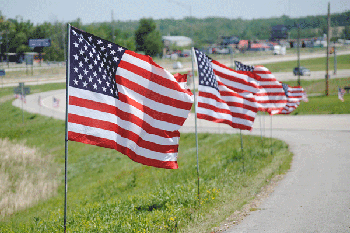
Friday, Nov. 11 is a Federal and Missouri State holiday, which means most government offices and area financial institutions will be closed Friday, Nov. 11 in observance of Veterans Day.
Closures include:
- Dexter City administrative and department offices will be closed. There will be no bulk trash pick-up on Friday.
- All Federal and Missouri state offices will be closed.
- The Stoddard County offices in Bloomfield will be closed.
- There will be no mail deliver on Friday by the U.S. Postal Service.
The following banks will also be closed Friday: Bank of Advance, First Commercial Bank, First Community Bank, First Midwest Bank, First State Bank & Trust, Montgomery Bank, Regions Bank, Southern Bank, U.S. Bank.
Dexter Public Schools will be in session, and all students kindergarten through 12th grade will attend the community Veterans Day observance at 9:30 a.m. Friday in the Bearcat Event Center.

By Annabeth Miller, SMT Editor
In continuing a decades-long tradition, Dexter will honor her veterans with a special program Friday morning.
In a new twist, the Daughters of the American Revolution have moved the Veterans Day observance to the Bearcat Event Center, where more veterans and their families, and all of the Dexter Schools’ students, can participate.
The Veterans Day Observance will be held at 9:30 a.m. Friday at the Bearcat Event Center on Grant Street. The community - especially veterans and their families - are invited to attend and participate.
Master of Ceremonies will be Dexter Mayor Joe Weber and guest speaker Major Roger Alsop, Missouri National Guard, Retired, will be the keynote speaker and the Rev. Phil Warren will deliver the invocation Joining them on stage will be Dexter native Col. Clifford Manlove, USAF Retired. Manlove has served as the Parade Marshal of the Dexter parade for several years.
Also participating in Friday’s program will be the Dexter High School band under the direction of Scott Rybolt.
The traditional awards for the 5th Grade Poster Contests and the 8th Grade Essay contest will be presented during the program .Sheila Alsup and Katie Alsup, representatives of the American Legion Auxiliary, will make the presentations.
Honoring Veterans
To honor the men and women of our Armed Forces, both past and present, here are several ways that folks are supporting these individuals:
At no cost other than your time, thank the troops directly by sending an e-greeting with your special message. Head to Facebook for the U.S. Army page, the U.S. Navy page, the Marines page, the U.S. Airforce page or the U.S. Department of Defense page. Or you can simply visit USO.org to leave your message with a few quick clicks.
- Facebook has unveiled a new U.S. Military page with the goal of bringing together resources and information to help the millions of military personnel, veterans and families stay connected and informed. Facebook has also launched "A Nation Gives Thanks" app in time for Veterans Day to give people the opportunity to thank active service members, veterans and their families for their service to our country.
- In honor of Veterans Day, Sam's Club locations nationwide will distribute 36,000 Hugo canes free of charge on November 9th-11th to U.S. military veterans in need of mobility assistance.
- Applebee's Neighborhood Grill and Bar is thanking our nation's veterans and active duty military for a third consecutive years this Veterans Day, by inviting them to their neighborhood Applebee's for a well-deserved free meal. A selection of complimentary entrees will be available for these local heroes on this day as dine-in guests at all Applebee's restaurants throughout the U.S.
- The American Red Cross and Pitney Bowes have teamed up for the fifth annual Holiday Mail for Heroes program. From now until Dec. 10, you are invited to send holiday cards to our American servicemembers, their families, and veterans all over the world. Anyone can send a card and you can send as many as you would like! Please send all cards to:
Holiday Mail for Heroes
P.O. Box 5456
Capitol Heights, MD
20791-5456

By Annabeth Miller, SMT Editor
We’ve heard the tone and the warnings through the years on television and radio, and some can remember the full-screen message from the 1960s that said “please stand by.”
But at 1 p.m. (Missouri time) on Wednesday, Nov. 9, there will be a different type of nationwide test.
A number of federal agencies are partnering tomorrow for the first nationwide test of the Emergency Alert System. Joining the program is the Federal Emergency Management Agency, the Federal Communications Commission, and the National Oceanic and Atmospheric Administration.
Over the past year, the agencies have been working with the broadcast community, cable operators and programmers, and other communications service providers that participate in the Emergency Alert System.
Here are specific items about the test:
- It will be conducted Wednesday, November 9 at 2 p.m. EST(1 p.m. in Missouri)
- It will be transmitted via television and radio stations within the U.S., including Alaska, Hawaii, the territories of Puerto Rico, the U.S. Virgin Islands, and American Samoa.
- Similar to local emergency alert system tests, an audio message will interrupt television and radio programming indicating: “This is a test.”
- When the test is over, regular programming will resume.
The National Emergency Alert System is an alert and warning system that can be activated by the president if needed to provide information to the American public during emergencies," White House press secretary Jay Carney told a gaggle of reporters Tuesday.
The test will only last about 30 seconds and will be broadcast on television and radio stations across the country.
"Just wanted to make sure everybody knows that it's just a test," Carney added.
Link of Interest
FEMA VideoBy Annabeth Miller, SMT Editor
A long-time police department employee was honored for more than three decades years of service at Monday evening’s meeting of the Dexter Board of Aldermen.
Jim Burge was recognized for his service to the Dexter Police Department at the aldermanic meeting. Mayor Joe Weber and Police Chief Sammy Stone presented Burge with a certificate and pin for his years of services to the community.
“He’s been with us for 35 years,” Weber said. “The voice of the Dexter Police Department! We certainly appreciate the work you’ve done. It’s certainly good to hear your voice we call the Police Department. “
The Streets and Sanitation Department is the recipient of new important equipment from the Stoddard County Health Department.
“They have given us a brand-new mosquito sprayer and a pallet of chemicals,” reported department chief Jeff Myers. The grant from the county health agency totaled a little over $9,000 and was picked up by city staff on Monday. The new equipment and chemicals will be ready to use for the 2012 season.
Park and Recreation Department Supt. Lawson Metcalf reported that most of the department’s summer and fall programs have ended for the season. He added that women’s volleyball is continuing and the fall and winter basketball program will begin soon.
“We have also been cutting some trees at West City Park. I did a little survey there recently it looks like we are going to have to cut over 20 trees,” Metcalf said. “Most of them are catalpa trees on the north end (of the park).”
Metcalf also mentioned that the water level at the Dexter Fishing Lake is as high as it has been in several years. He said that recent work to repair leaks on the lake on One Mile Road has been successful, although there are some leaks that will be repaired in the future.
“We still want to raise that water level up about another foot,” he said.
In other business Monday evening,
- Library Director Pam Trammell report the Friends of the Library organization gave the library $1,000 to be used as a grant match for the purchase of new computers;
- The annual Book Sale at Keller Public Library is set for 9 a.m. until 2 p.m. on Saturday, Nov. 19;
- City Administrator Mark Stidham reminded aldermen of the Veterans Day Observance at 9:30 a.m., Friday, Nov. 11 at the Bearcat Event Center. This observance will take the place of the Veterans Day Parade in Downtown Dexter;
- City offices will be closed this Friday, Nov. 11, in observance of Veterans Day.

By Anthony Schick
The Columbia Missourian
MISSISSIPPI COUNTY — Six months after it was under water, the land behind the Birds Point levee blast is a patchwork of soybean fields.
Farmers are midway through harvest in the 130,000 acres of fertile Mississippi River bottom — land many thought would be unusable this season and would take years to recover after the U.S. Army Corps of Engineers breached the Birds Point levee on May 2.
Although homes, roads and other property in the Birds Point-New Madrid Floodway were damaged or destroyed by the flooding, the land itself recovered faster than anyone expected.
Floodwaters began subsiding in late May, and farmers were at work in their fields planting soybeans as early as the first of June.
Farmers planted soybeans along with some corn and milo on 90 to 95 percent of the land that was submerged, Sam Atwell, a University of Missouri Extension agronomist in New Madrid County, estimated. The flood caused permanent damage to less than 1 percent of the 130,000 acres, he said.
“The land itself came out better than we thought,” Atwell said. “You can’t imagine really swift water 30 feet deep going miles across fields and not hurting the land more than it did.”
He and most others in the spillway imagined a year without a harvest when the corps opted to open the floodway for the first time since 1937.
The corps’ plan, outlined in the Flood Control Act of 1928 and most recently updated in 1986, calls for blasting open portions of the Birds Point levee when the Mississippi River begins to overtop it. The spillway is designed to prevent unexpected levee failures at Cairo, Ill., and other locations up and down the river.
The decision to breach the levee was not without protest on the Missouri side of the river.
Missouri Attorney General Chris Koster filed a federal lawsuit April 26 in an attempt to halt the levee breach.
"The flooding would leave a layer of silt on the farmland that could take as much as a generation to clear, causing significant injury to the quality of the farmland for many years,” a news release from Koster’s office said.
The Supreme Court denied Missouri's challenge May 1. The next day, the corps blew the first section of the levee, followed soon after by a second and third blast.
The entire spillway was under water weeks after the levee blew. The farmland didn’t flood gradually as it usually does, Atwell said; essentially, the full force of the Mississippi River hit the land.
The river washed away about 20,000 acres of winter wheat ready for harvest and soaked fields that were graded and ready for corn planting. For those with crop insurance, the federal government will cover farmers’ losses for the costs of planting, according to statement from the U.S. Department of Agriculture.
About half the farmers in the spillway do not have crop insurance because of the high cost, Atwell said.
“Up near Columbia, crop insurance is a no-brainer," he said. "But in the floodway, many can’t afford it."
The topsoil losses, high water and lost inputs led to grim predictions for the season’s outcome.
In early June, at the request of Missouri congresswoman Jo Ann Emerson, the Food and Agricultural Policy Research Institute at MU estimated crop losses caused by the flooding. The institute assumed that no crops would be planted on any of the 130,000 acres in the floodway.
That estimate put farm losses at $42.6 million — $60.6 million before crop and disaster insurance payouts. The total economic decline from those crop losses would be near $157 million, according to the institute.
Losses will not be near those numbers, though.
“I don’t know what our losses are going to be, but it’s definitely not going to be catastrophic except maybe in a few places,” Atwell said.

"We didn't want our grounds, want our livelihood, want our houses, want our residences destroyed by the onslaught of water that came through the floodway," Mainord said in the video "Man Made: Disaster at Birds Point," which examines the corps' decision to breach the levee and the ensuing damage. "We feel like we were sacrificed," he said.
In mid-May, his land in the floodway was 20 feet under water.
Six months later, the teeth on Mainord’s John Deere combine were littered with dried stalks and leaves from freshly harvested soybeans. Hundreds more acres awaited. Mainord farms about 2,800 acres in the center of the floodway, along with 4,500 outside of the floodway. He got all but 100 acres of his land in the floodway planted this year.
"I think a lot of farmers feel blessed to have a crop this year," he said.
Mainord was one of few farmers to plant several hundred acres of corn, which takes longer to mature than soybeans and wasn’t an option in most places because of the late planting season.
Corn prices were at an all-time high in June, near $7 per bushel.
“Farmers take losses a lot of years hoping to make it back with one good one,” Mainord said. “If this was one of those years you had to make that profit, you lost those opportunities.”
Opportunities might be higher next planting season, when the 10 percent or so of farmland that didn’t get planted this year returns to production. Some of the badly flooded land returned this year.
The levee breach blew about a quarter of the levee into chunks on Robert Henry’s farm, which starts at the base of the levee at the site of the second blast and runs west for about a quarter mile. The river tore about 150 tons of topsoil per acre from half of Henry’s land, MU Extension scientists estimated. The tops of tree stumps are poking out of the ground in some places for the first time since he can remember.
Henry got all but 15 of his 1,000 acres replanted in July, and he said the rest will be back in production next season.
Henry, 62, has been farming in the spillway since he was 19. It cost him about $80,000 more than usual to clear his land, level it and plant it in time. This season is the latest he’s ever planted. He has about 800 to 900 acres of soybeans that won’t be ready for another couple weeks.
This year's harvest is nearly a month late in the floodway and will run through the end of November, meaning it could get cut short by frost. Temperatures between 28 and 30 degrees for consecutive hours will damage beans, Mainord said.
Yields are in the range of 30 to 50 bushels per acre compared to 40 to 60 bushels per acre, yields farmers in the floodway have come to expect, Atwell said. Soybean harvests throughout Missouri are yielding an average of 37 bushels per acre, according to USDA statistics.
The status of the Birds Point levee has farmers anxious about future harvests, though, Mississippi County Farm Services Agency Director Dickey Jordan said.
The levee stood 61.5 feet before the breach. The corps expects to have a 51-foot temporary fix in place by Nov. 30 and recently announced $3 million in funding to raise the levee to 55 feet. At that height, the river has a 6 percent chance of overtopping the levee at any time, the corps estimated.
Floodway insurance prices have risen because of the lowered levee, Jordan said.
The corps is seeking $1 billion to repair damages in the Mississippi basin, $75 million of which has been allocated. That means many projects, including restoring the levee to 61.5 feet, are on hold until Congress makes the money available.
“At first, farmers were anxious about not having a crop. Then they were anxious about yields, but they ended up with a crop,” Jordan said. “But they’re still looking at that levee not there, and they’re still anxious. So they’re thankful for what they’ve got.”
Editor's Note: This news report by Anthony Schick is reprinted with permission from the Columbia Missourian. Anthony is a graduate student in the School of Journalism at the University of Missouri - Columbia. He has been reporting on the flooding along the Mississippi River and the breach of the Birds Point levee since last spring. This article was published in the Columbia Missourian on Nov. 4, 2011.

